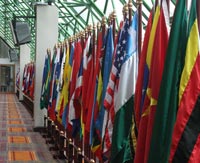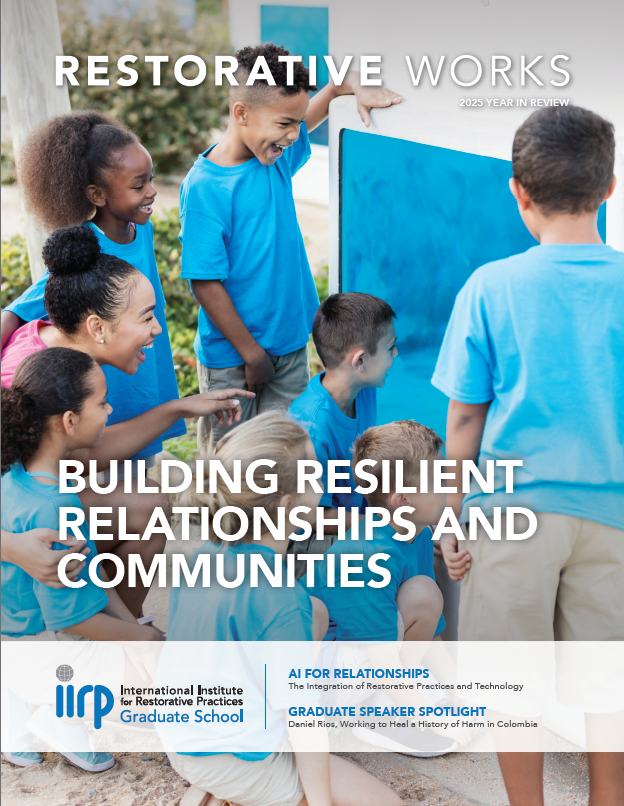News & Announcements
 Flags from many nations stand outside the U.N. Crime Congress plenary hall.Restorative justice is playing an increasingly significant role in countries all over the globe, and its influence will likely continue to grow. That message emerged clearly-and in many languages-when people from around the world gathered for the Eleventh United Nations Congress on Crime Prevention and Criminal Justice, held April 18-25, 2005, in Bangkok, Thailand.
Flags from many nations stand outside the U.N. Crime Congress plenary hall.Restorative justice is playing an increasingly significant role in countries all over the globe, and its influence will likely continue to grow. That message emerged clearly-and in many languages-when people from around the world gathered for the Eleventh United Nations Congress on Crime Prevention and Criminal Justice, held April 18-25, 2005, in Bangkok, Thailand.
The congress established a “new high-water mark” for restorative justice on the U.N. stage, said IIRP Director of Research Paul McCold, who participated in the event and witnessed an unprecedented level of interest in restorative practices.
 Honor student and second-degree black belt in karate Gino LeeFamily group decision making (FGDM, also known as family group conferencing or FGC) has made a big difference in the lives of many families. The story of how FGDM helped one family in Los Angeles County, California, USA, is a textbook example of just how powerful the FGDM process can be. FGDM helped this family ensure the well-being of a child who had fallen through the cracks of the child welfare system. Through an FGDM conference, the child’s extended family was empowered to make a plan for him, and this once troubled boy is now thriving and happy, living with his birth parents.
Honor student and second-degree black belt in karate Gino LeeFamily group decision making (FGDM, also known as family group conferencing or FGC) has made a big difference in the lives of many families. The story of how FGDM helped one family in Los Angeles County, California, USA, is a textbook example of just how powerful the FGDM process can be. FGDM helped this family ensure the well-being of a child who had fallen through the cracks of the child welfare system. Through an FGDM conference, the child’s extended family was empowered to make a plan for him, and this once troubled boy is now thriving and happy, living with his birth parents.
Not long after Gino Lee was born, his mother, Gina, had a nervous breakdown, and his father, Carl, took her to the hospital. Afraid that Gina might pose a threat to her child, the hospital staff contacted the Los Angeles County Department of Children and Family Services (DCFS).
An article onrestorative practices in schools appears in the May 17, 2005, editionof School Board News, published by the National School BoardsAssociation, a nonprofit federation of state associations of schoolboards that represents about 15,000 local school districts throughoutthe United States. The report, by Carol Chmelynski, covers restorativeinitiatives across the US, including PEASE Academy, a school inMinnesota for students recovering from drug and alcohol addiction, apilot program in six Wisconsin school districts and the IIRP''sSaferSanerSchools program.
| Queanbeyan South Public School is a 2004 winner of an Australian Crime and Violence Prevention Award, sponsored by the governments of Australia and New Zealand, for “Real Justice in a Safe and Happy School.” |
Restorative practices have proved a success at a primary school in Australia, where teachers have discovered that discipline works much better when the children themselves take part in the process.
A few years ago, Queanbeyan South Public School, in New South Wales, just outside the Australian capital of Canberra, was struggling with persistent problems of bullying, violence and absenteeism among its pupils. Conventional punishments like detentions and suspensions didn’t seem to help. “We were just chasing our tails,” recalled teacher Elizabeth Harley, who said that disrespect for authority and low self-esteem were common among the students.
"Supporting Pupils, Schools and Families: An Evaluation of the Hampshire Family Group Conferences in Education Project,"a report by the University of Sheffield, England, UK, evaluates 50family group conferences (FGCs) carried out in schools in HampshireCounty, from implementation through many months after each conference.The FGCs were meant to help young people aged 5-15 with behavior andattendance problems, but often addressed family and welfare issues aswell. FGCs were seen as having a significantly positive effect:Presenting problems improved in over half of the young people studied;90 percent of family members said they would recommend FGCs to others;and young people said they found the FGCs to be helpful.
Information on the IIRP''s conference in Penrith, New South Wales, Australia, March 3-5, 2005, including plenary sessions.
In this paper, Shannon Pakura, chief social worker, New Zealand Department of Child, Youth and Family Services, Wellington, New Zealand, discusses the challenges that family group conferencing (FGC) has encountered and acknowledges successes achieved since FGC has been integrated into New Zealand''s youth justice and child welfare systems. The paper was presented at the third in a series of three IIRP conferences with the theme, "Building a Global Alliance for Restorative Practices and Family Empowerment," in Penrith, Australia, March 3-5, 2005.
This paper by Jenny Bargen, director, Youth Justice Conferencing, New South Wales Department of Juvenile Justice, Australia, focuses on New South Wales''Young Offenders Act 1997 (YOA) as a case study in the success of restorative conferencing. The paper was presented at the third in a series of three IIRP conferences with the theme, "Building a Global Alliance for Restorative Practices and Family Empowerment," in Penrith, Australia, March 3-5, 2005.
This paper is an overview of important developments in restorative justice in the UK, by Les Davey, director of Real Justice United Kingdom and Ireland and a founding member of the Thames Valley Police Restorative Justice Consultancy. Davey discusses initiatives by police and county councils; and pilots, research, best practice guidelines and legislation supported by the Home Office. The paper was presented at the third in a series of three IIRP conferences with the theme, "Building a Global Alliance for Restorative Practices and Family Empowerment," in Penrith, Australia, March 3-5, 2005.
This paper by Brenda Morrison, research fellow, Centre for Restorative Justice, Australian National University, endorses the use of restorative justice in schools, particularly as a response to bullying. Bullying, she says, is about the abuse of power, while restorative justice is about empowerment through building relationships. The paper was presented at the third in a series of three IIRP conferences with the theme, "Building a Global Alliance for Restorative Practices and Family Empowerment," in Penrith, Australia, March 3-5, 2005.
